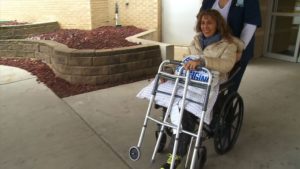
Adela Alvarez and Nan Martin
By Marissa Alanis
Nan Martin hadn’t planned on attending the Zumba class that her friend and instructor, Adela Alvarez, taught at Hope Community Church in Rogers, a small town in the Minneapolis–St. Paul area.
But wintry weather on Jan. 9, 2014 led Martin’s personal trainer to cancel their appointment. Undeterred by the weather, Martin didn’t want to stay at home. She headed to the Zumba class instead, which was the first time she attended Alvarez’s Thursday night class. Martin usually went to her class on Monday nights.
Alvarez, who was 49, taught at least five Zumba classes each week in addition to working as a high school Spanish teacher. Halfway through the class, Alvarez decided to give the students a water break.
“She is leaning against the wall, taking a sip of water and she almost looked right through me and she just said, ‘I don’t feel well,” Martin recalled. “She just collapsed.”
Martin, who had renewed her AHA CPR training a week before, immediately checked Alvarez’s pulse while another student ran to call 911. Martin detected a faint pulse and gave Alvarez two rescue breaths.
Martin checked her pulse again. There was no pulse. The dispatcher, who was on the phone by this time, told Martin to start compressions and remained on the line to guide her.
“She would say ‘Speed it up’ or ‘You’re going too slow’,” Martin recalled. “She helped me keep my pace up, which was great.”
As Martin did CPR, she sang the song Stayin’ Alive, which has the right beat for performing chest compressions. When performing CPR, rescuers should push on the chest at a rate of 100 to 120 compressions per minute.
“It’s so weird, but I wasn’t scared,” she said. “I was amazed at the adrenaline – the whole adrenaline rush. I knew what I had to do and it’s so different when you’re doing CPR on a manikin versus when you’re doing CPR on someone you love.”
Martin performed CPR for about 25 minutes before emergency help arrived at the church, which is located in a rural area. First responders from about three to four nearby communities arrived. The paramedics shocked Alvarez’s heart five times before rushing her to the hospital.
In the first week of hospitalization, Alvarez had kidney failure and liver failure. She started to become weak. Doctors had to use an ECMO machine to help her heart. But Alvarez experienced complications and lost circulation in her right leg. Doctors had to amputate her leg above the knee.
It was about 45 days after her cardiac arrest that Alvarez started to come out of her coma.
“When they take me out of the medicines for the coma, they were able to do a CAT scan and the doctors came out and literally say to my husband, ‘It’s a miracle. Her brain has zero damage. It was as if nothing happened,” she said.
Alvarez spent about three months in the hospital. She attributes her faith in God, prayers from family and friends and gratitude with helping her survive and recover.

“I know that God was there all the time with me,” she said. “Even though it wasn’t easy because in the recovery, I remember feeling a lot of physical pain. …I was so grateful to be alive. That was my thing – be grateful. I’m alive. I say ‘It’s ok. I don’t have a leg. I can’t live without a heart. It’s okay if I live without a leg.’
Pictured above: Adela leaving the hospital.
Later in 2014, Alvarez received the Zumba Fitness Inspiration Award at the Zumba convention in Orlando. A nurse who was also a Zumba instructor was inspired by Alvarez’s story at the event that she helped lead efforts to teach CPR to Zumba instructors. CPR is now taught to instructors at the annual convention.
Alvarez is now an AHA CPR instructor who teaches BLS and runs a CPR training business. She teaches once a month at the high school where she previously worked as a Spanish teacher.
“I love it,” she said. “I share my story in every class. After I share my story, it changes the point of view of the people in the class.”

Pictured above: Adela, center, is now a CPR training instructor.
Martin has followed Alvarez’s footsteps and now is a Zumba instructor. Martin said Alvarez is never far from her thoughts.
“I really miss dancing with her,” she said. “Number one – she is an amazing woman. Even before all of this happened, Adela is just one of those shining lights who walks into the room and you can feel it come off of her. Her classes were amazing.”
Martin said she urges the public to take a CPR training class because it can save the life of someone you know or love.
“I just can’t emphasize enough – take it,” she said. “A lot of people say,’ I’ll never need that. I’ll never use that.’ Never say never because you know never know when a 49-year-old fit woman is going to drop in front of you.”
This National CPR and AED Awareness Week, learn more about how you could save the life of a loved one or someone you know by learning CPR today.